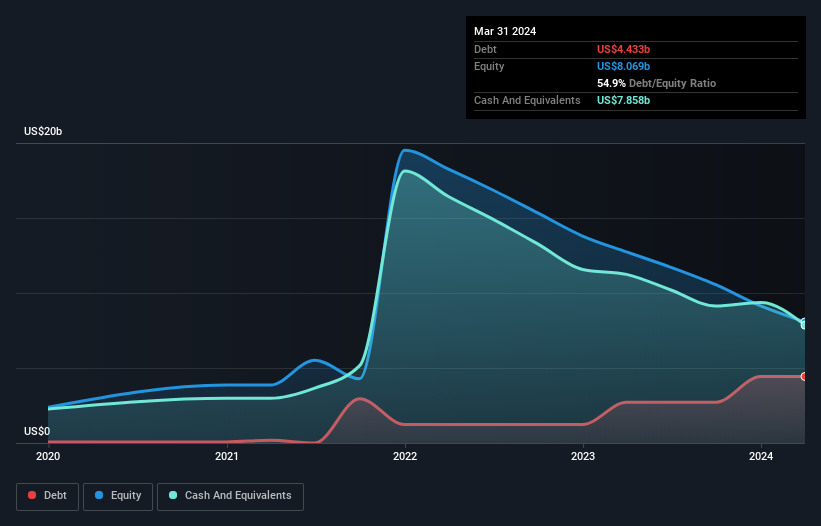
Warren Buffett famously said, 'Volatility is far from synonymous with risk.' It's only natural to consider a company's balance sheet when you examine how risky it is, since debt is often involved when a business collapses. Importantly, Rivian Automotive, Inc. (NASDAQ:RIVN) does carry debt. But should shareholders be worried about its use of debt?
What Risk Does Debt Bring?
Debt assists a business until the business has trouble paying it off, either with new capital or with free cash flow. Ultimately, if the company can't fulfill its legal obligations to repay debt, shareholders could walk away with nothing. However, a more usual (but still expensive) situation is where a company must dilute shareholders at a cheap share price simply to get debt under control. Of course, the upside of debt is that it often represents cheap capital, especially when it replaces dilution in a company with the ability to reinvest at high rates of return. The first thing to do when considering how much debt a business uses is to look at its cash and debt together.
View our latest analysis for Rivian Automotive
What Is Rivian Automotive's Debt?
As you can see below, at the end of March 2024, Rivian Automotive had US$4.43b of debt, up from US$2.72b a year ago. Click the image for more detail. But it also has US$7.86b in cash to offset that, meaning it has US$3.43b net cash.

A Look At Rivian Automotive's Liabilities
According to the last reported balance sheet, Rivian Automotive had liabilities of US$2.40b due within 12 months, and liabilities of US$5.26b due beyond 12 months. On the other hand, it had cash of US$7.86b and US$389.0m worth of receivables due within a year. So it actually has US$582.0m more liquid assets than total liabilities.
This short term liquidity is a sign that Rivian Automotive could probably pay off its debt with ease, as its balance sheet is far from stretched. Simply put, the fact that Rivian Automotive has more cash than debt is arguably a good indication that it can manage its debt safely. When analysing debt levels, the balance sheet is the obvious place to start. But it is future earnings, more than anything, that will determine Rivian Automotive's ability to maintain a healthy balance sheet going forward. So if you're focused on the future you can check out this free report showing analyst profit forecasts.
Over 12 months, Rivian Automotive reported revenue of US$5.0b, which is a gain of 124%, although it did not report any earnings before interest and tax. So its pretty obvious shareholders are hoping for more growth!
So How Risky Is Rivian Automotive?
We have no doubt that loss making companies are, in general, riskier than profitable ones. And the fact is that over the last twelve months Rivian Automotive lost money at the earnings before interest and tax (EBIT) line. And over the same period it saw negative free cash outflow of US$5.6b and booked a US$5.5b accounting loss. But at least it has US$3.43b on the balance sheet to spend on growth, near-term. Importantly, Rivian Automotive's revenue growth is hot to trot. High growth pre-profit companies may well be risky, but they can also offer great rewards. There's no doubt that we learn most about debt from the balance sheet. But ultimately, every company can contain risks that exist outside of the balance sheet. For example - Rivian Automotive has 2 warning signs we think you should be aware of.
If, after all that, you're more interested in a fast growing company with a rock-solid balance sheet, then check out our list of net cash growth stocks without delay.
New: AI Stock Screener & Alerts
Our new AI Stock Screener scans the market every day to uncover opportunities.
• Dividend Powerhouses (3%+ Yield)
• Undervalued Small Caps with Insider Buying
• High growth Tech and AI Companies
Or build your own from over 50 metrics.
Have feedback on this article? Concerned about the content? Get in touch with us directly. Alternatively, email editorial-team (at) simplywallst.com.
This article by Simply Wall St is general in nature. We provide commentary based on historical data and analyst forecasts only using an unbiased methodology and our articles are not intended to be financial advice. It does not constitute a recommendation to buy or sell any stock, and does not take account of your objectives, or your financial situation. We aim to bring you long-term focused analysis driven by fundamental data. Note that our analysis may not factor in the latest price-sensitive company announcements or qualitative material. Simply Wall St has no position in any stocks mentioned.
About NasdaqGS:RIVN
Rivian Automotive
Designs, develops, manufactures, and sells electric vehicles and accessories.
Excellent balance sheet with limited growth.
Similar Companies
Market Insights
Community Narratives



